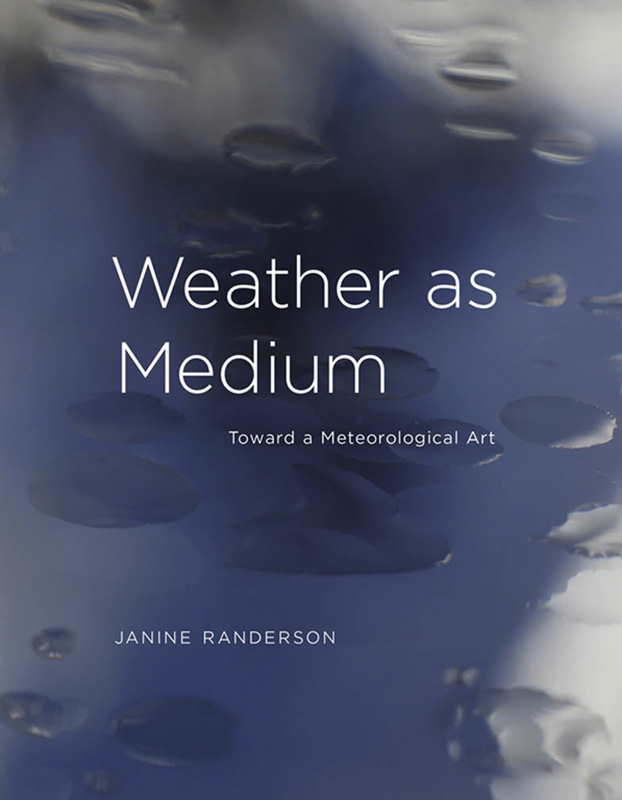Janine Randerson: Weather as Medium: Toward a Meteorological Art (2018)
Filed under book | Tags: · art, art criticism, climate, cosmology, ice, indigenous peoples, maori, media, meteorology, science, sensors, weather, wind

“An exploration of artworks that use weather or atmosphere as the primary medium, creating new coalitions of collective engagement with the climate crisis.
In a time of climate crisis, a growing number of artists use weather or atmosphere as an artistic medium, collaborating with scientists, local communities, and climate activists. Their work mediates scientific modes of knowing and experiential knowledge of weather, probing collective anxieties and raising urgent ecological questions, oscillating between the “big picture systems view” and a ground-based perspective. In this book, Janine Randerson explores a series of meteorological art projects from the 1960s to the present that draw on sources ranging from dynamic, technological, and physical systems to indigenous cosmology.
Randerson finds a precursor to today’s meteorological art in 1960s artworks that were weather-driven and infused with the new sciences of chaos and indeterminacy, and she examines work from this period by artists including Hans Haacke, Fujiko Nakaya, and Aotearoa-New Zealand kinetic sculptor Len Lye. She looks at live experiences of weather in art, in particular Fluxus performance and contemporary art that makes use of meteorological data streams and software. She describes the use of meteorological instruments, including remote satellite sensors, to create affective atmospheres; online projects and participatory performances that create a new form of “social meteorology”; works that respond directly to climate change, many from the Global South; artist-activists who engage with the earth’s diminishing cryosphere; and a speculative art in the form of quasi-scientific experiments. Art’s current eddies of activity around the weather, Randerson writes, perturb the scientific hold on facts and offer questions of value in their place.”
Publisher MIT Press, 2018
Leonardo series
ISBN 9780262038270, 0262038277
xl+233 pages
Deborah R. Coen: Climate in Motion: Science, Empire, and the Problem of Scale (2018)
Filed under book | Tags: · austria-hungary, climate, history of science, meteorology, science

“Today, predicting the impact of human activities on the earth’s climate hinges on tracking interactions among phenomena of radically different dimensions, from the molecular to the planetary. Climate in Motion shows that this multiscalar, multicausal framework emerged well before computers and satellites.
Extending the history of modern climate science back into the nineteenth century, Deborah R. Coen uncovers its roots in the politics of empire-building in central and eastern Europe. She argues that essential elements of the modern understanding of climate arose as a means of thinking across scales in a state—the multinational Habsburg Monarchy, a patchwork of medieval kingdoms and modern laws—where such thinking was a political imperative. Led by Julius Hann in Vienna, Habsburg scientists were the first to investigate precisely how local winds and storms might be related to the general circulation of the earth’s atmosphere as a whole. Linking Habsburg climatology to the political and artistic experiments of late imperial Austria, Coen grounds the seemingly esoteric science of the atmosphere in the everyday experiences of an earlier era of globalization.
Climate in Motion presents the history of modern climate science as a history of “scaling”—that is, the embodied work of moving between different frameworks for measuring the world. In this way, it offers a critical historical perspective on the concepts of scale that structure thinking about the climate crisis today and the range of possibilities for responding to it. ”
Publisher University of Chicago Press, 2018
ISBN 9780226398822, 022639882X
xiv+425+[4] pages
Review: Mott Greene (Nature, 2018).
Comment (0)International Journal of Communication, 8: Special Section: Media, Hot and Cold (2014)
Filed under journal | Tags: · climate, media, media studies, mediation, meteorology, temperature, weather
“The 21st century will be the century of temperature. As global temperatures rise, polar ice melts, and drought becomes a permanent way of life, temperature has become the single greatest challenge to human life on the planet.
Temperature is also a media problem in many ways: from the heat generated by new media—whether in our hands or in giant server farms; to the technologies used to measure, represent, and understand temperature; to the contribution of new media systems themselves to the problem of global warming. But this is not a new phenomenon. For centuries, media and mediation have been at the center of experiments in and beliefs about temperature and its relation to culture, gender, language, and life. In this special section, we take the 50th anniversary of Marshall McLuhan’s Understanding Media literally to ask “What are hot and cold media?””
Contributors: Alice Christensen, Wolfgang Ernst, Brenton J. Malin, Jessica Mudry, Dylan Mulvin, Lisa Parks, Rafico Ruiz, Nicole Starosielski, Jonathan Sterne, Marita Sturken.
Special section of the IJoC 8
Edited by Dylan Mulvin and Jonathan Sterne
Creative Commons BY-NC-ND License
ISSN 1932-8036
44 pages
PDF (single file)
PDFs (separate articles)

